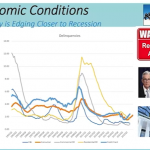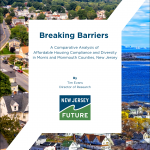New Jersey Future Blog
Hispanic Heritage Month and the Growth of New Jersey’s Latinx Population
October 13th, 2021 by Bailey Lawrence

This summer, the Colombian flag was raised at City Hall in Jersey City. The city held flag raising ceremonies to celebrate the independence of several Latin American countries. Photo credit: Bailey Lawrence
Some of my favorite stories are the ones my grandparents tell me about their journey from Bolivia to the U.S.—about finding their first jobs, struggling to “fit in,” and raising a family of six in a North Jersey suburb. Stories about finding a sense of community in an unfamiliar place.
My grandfather often reminds me that he would not be where he is today if not for other South American immigrants—as well as New Jersey and Pennsylvania natives—who helped him build a home, learn English, and ultimately attend Rutgers University (the first in a long line of Rutgers alumni).
Neighbors and relationships like these form the social and economic foundations of an increasing number of communities across the country. Indeed, following the recent release of 2020 United States Census Bureau data, both national policy organizations and popular media outlets highlighted the increasing diversity of the U.S. population (as well as the diminishing size of the country’s white population). According to a New Jersey Future article published in September, diversity in the Garden State is similarly growing. New Jersey’s overall diversity index—the probability that two randomly selected individuals will be members of different racial groups—increased from 59.3% in 2010 to 65.7% in 2020.
Latinx population growth has significantly contributed to such burgeoning diversity, both nationally and statewide. In 2020, “people of Hispanic origin” constituted the second largest racial or ethnic group in the U.S., and one of the fastest-growing racial and ethnic groups in the country. Only Asian Americans grew at a faster rate between 2010 and 2020 (35.6% vs. 23%), according to The Brookings Institution.
During the same decade, New Jersey’s Hispanic population grew by nearly half a million people (447,431), which equates to a growth rate of 28.8% between 2010 and 2020 (compared to the state’s overall population growth rate of 5.7%).
The Hispanic population also increased in all 21 New Jersey counties. While Hudson County maintained its plurality-Hispanic status, Passaic County shifted from plurality non-Hispanic white to plurality-Hispanic.
At the municipal level, the Hispanic population increased in all but 32 of New Jersey’s 565 municipalities. Among these municipalities, 23 contain an outright Hispanic majority, including seven whose Hispanic populations constitute 70% or more of their overall populations—Perth Amboy (83.2% Hispanic), Union City (82.4%), Dover (77.0%), West New York (75.8%), Victory Gardens (74.9%), Passaic (73.1%), and North Bergen (70.9%).
Additionally, 39 New Jersey municipalities are now plurality-Hispanic, compared to 25 municipalities in 2010. Among these municipalities, 15 attained plurality-Hispanic status in 2020, including Trenton, the state capital and home of New Jersey Future.
While we should certainly celebrate the growth of New Jersey’s Latinx population, the state’s increasing diversity should not invite complacency. Diversity alone is less valuable in a society in which Black and brown people still lack access to resources and opportunities—a society in which we still fail to equitably distribute power and ensure ownership in communities of color. This Hispanic Heritage Month—and every month—we must recognize that diversity is merely the starting point.
Related Posts
Tags: Demographics, equity, New Jersey, Population
















